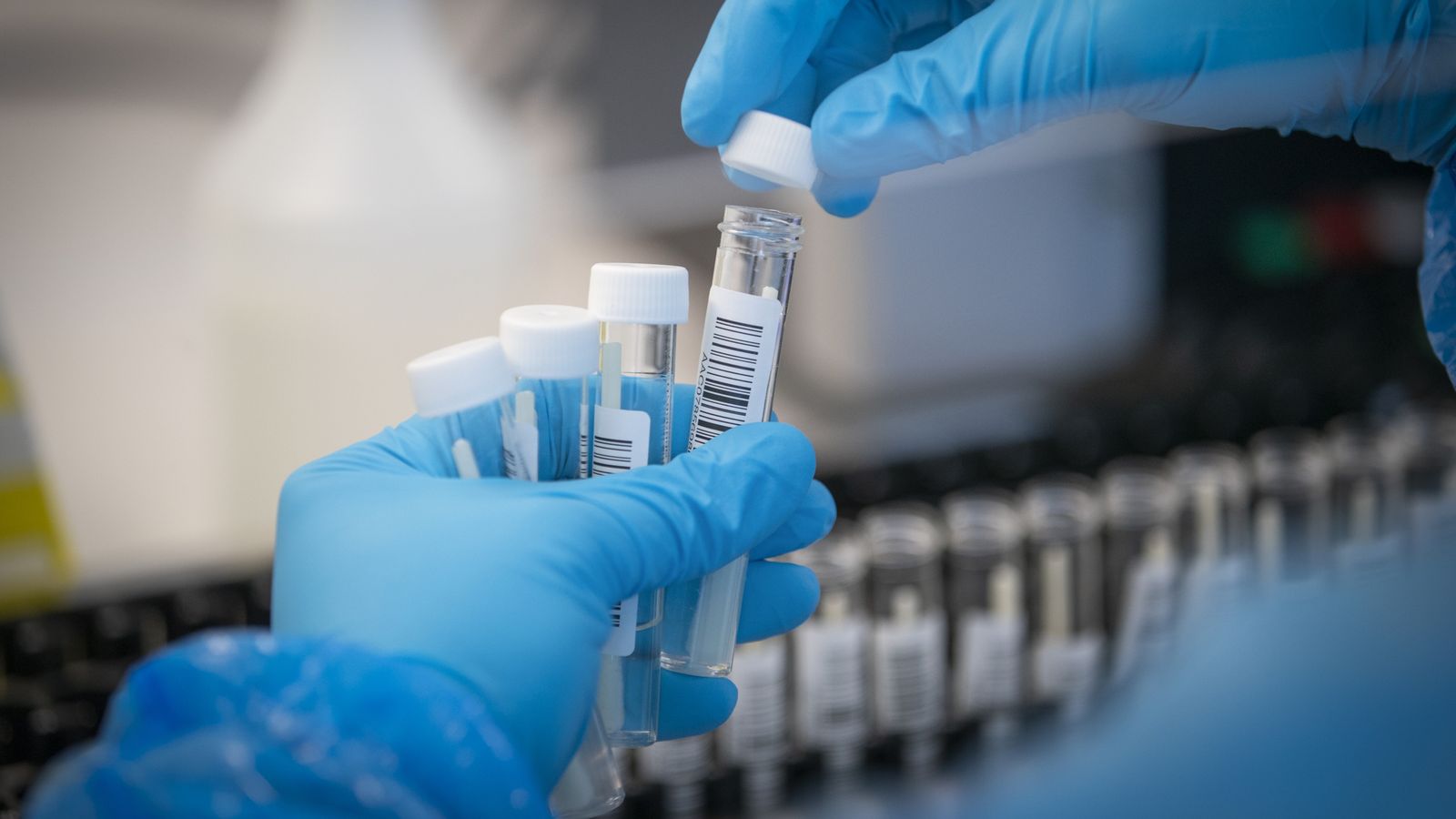Another 92,368 coronavirus cases were reported for the UK on Monday – a steep rise on the previous day due to a reporting method change.
Reinfections have never been included in daily figures for Northern Ireland, Scotland and England (they have in Wales if the positive test came after 42 days) – meaning people who caught the virus for a second time were not included.
However, for the first time since the start of the pandemic, reinfections in England and Northern Ireland are now being included on the daily COVID dashboard.
COVID news live – updates from the UK and across the globe
What has changed?
Repeat positive tests were not previously included in the data.
The change, which was implemented for Northern Ireland and England from yesterday, means people will be counted if they test positive at least 90 days after their last test.
COVID: UK reports lowest number of daily coronavirus cases since 14 December
COVID-19: North Korea set to reopen borders and resume trading with China
England rugby: Eddie Jones says he will find replacements for players unvaccinated against COVID-19
Data for Scotland will also be included in the coming weeks, while reinfections in Wales will soon be counted using the 90-day timescale.
Please use Chrome browser for a more accessible video player
What does this mean for daily case numbers?
The reporting method change resulted in a significant spike of cases.
Monday’s figure came after 52,295 cases were reported on Sunday – the lowest figure since 14 December before Omicron had peaked.
As for the daily deaths figure, this was 51 yesterday, giving a total of 155,754 deaths within 28 days of a positive test.
The total number of deaths with COVID on the death certificate currently stands at 176,813.
Please use Chrome browser for a more accessible video player
Under-reporting
The number of new cases reported by the government has always been lower than the level estimated by the Office for National Statistics, but the gap has become wider since the arrival of the Omicron variant.
High levels of under-reporting will still be affecting the government’s daily figures, meaning the true volume of cases in the UK is increasingly unclear.
The dashboard numbers are limited to all positive lab-confirmed PCR test results in the UK, plus positive lateral flow tests in Northern Ireland and, in England, any positive lateral flow tests not followed by a negative PCR test taken within 72 hours.
Although the dashboard will now also include figures for COVID-19 reinfections in England and Northern Ireland – this data will still be affected by how many people are reporting their test results.
Follow the Daily podcast on Apple Podcasts, Google Podcasts, Spotify, Spreaker
Reinfections spiked during Omicron wave
Professor Steven Riley, director general of data and analytics at the UK Health Security Agency (UKHSA), said: “Reinfection remained at very low levels until the start of the Omicron wave.
“It is right that our daily reporting processes reflect how the virus has changed.
“We continue to see downward trends in case numbers and incidence of illness as we work to reduce the impact of the pandemic on our day-to-day lives.
“With vaccination still a great defence against infection and illness, please get jabbed as soon as possible.”
Science correspondent
If you look at the official chart of reported COVID cases this morning the peaks are that little bit taller, the trajectories that little bit sharper – particularly in the Omicron wave.
That’s because overnight the UK Health Security Agency added reinfections to the government dashboard.
Omicron’s ability to evade the antibodies from a previous bout of COVID has more significantly increased the reinfection rate in the current wave.
Before 1 December 2021, when Omicron cases started to surge, there had only been 82,080 reinfections. Since then there have been 506,034.
Does that mean the UK’s epidemic has been even worse than we thought?
Well, no.
The official data misses huge numbers of cases, for all sorts of reasons: some infections have no symptoms, some people don’t test even when they do have symptoms and some don’t report a positive lateral flow test.
The weekly survey by the Office for National Statistics, which randomly tests people, whether or not they have symptoms, consistently puts the infection rate far higher than the government dashboard suggests.
Professor Paul Hunter at the University of East Anglia estimates that only four in every 10 infections recorded by the ONS make it onto the dashboard, perhaps even fewer in the Omicron wave.
And even though possible reinfections are now included in the official data, there are still big gaps.
The ONS survey provides the most accurate picture of the UK epidemic, which is why we make a big deal of it when it comes out each week.
The daily dashboard is that little bit more accurate now though. And it still reliably shows trends – and at the moment cases are, happily, falling.






















